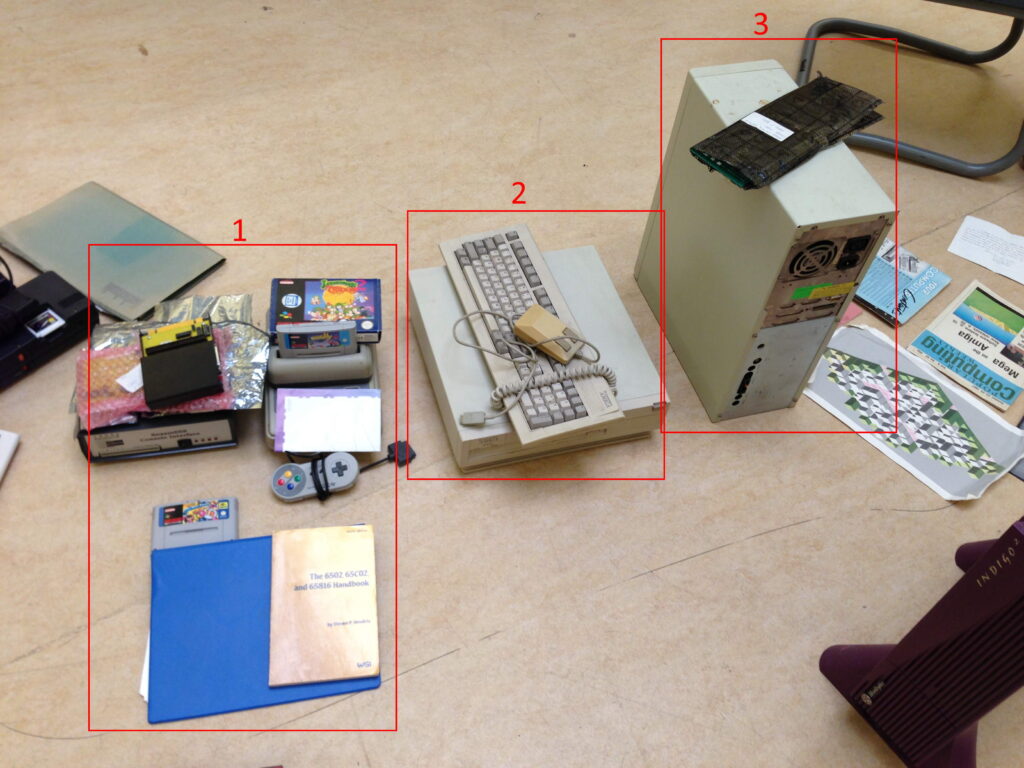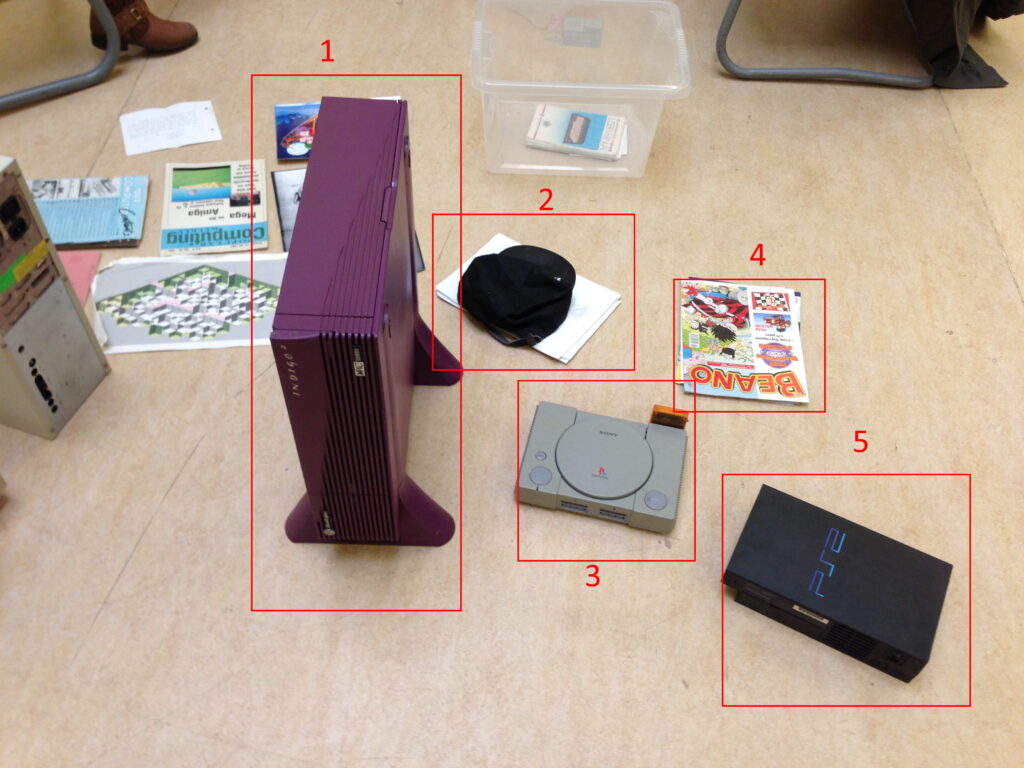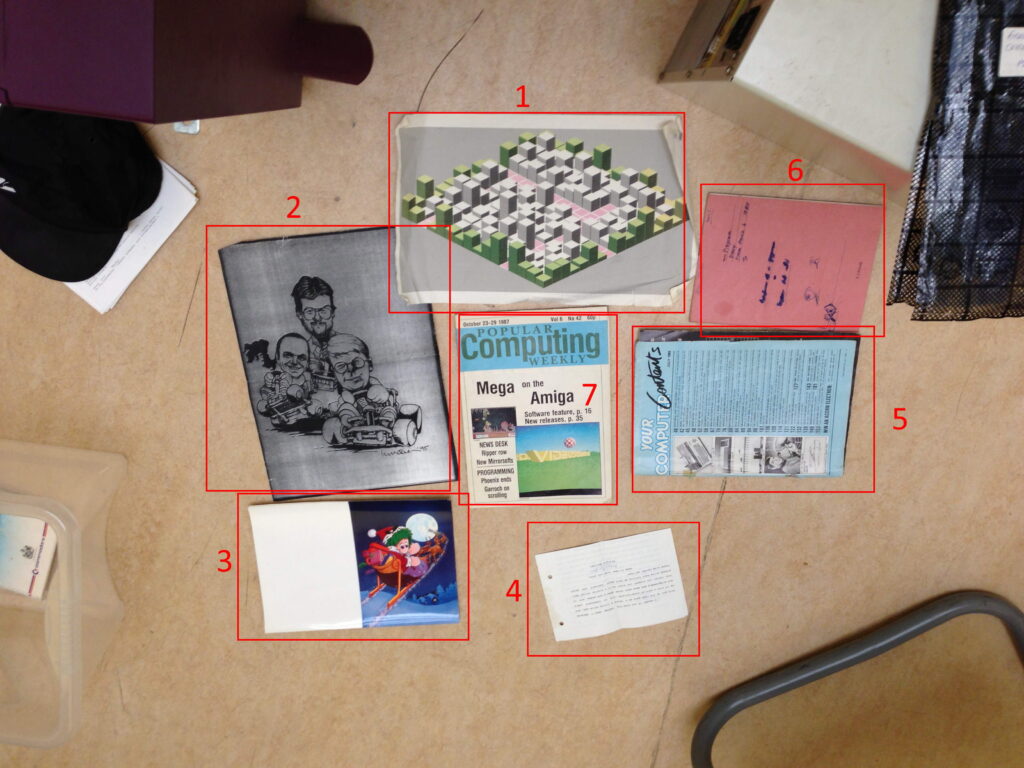I came across photos of the items I’d donated to the local Museum – the McManus Gallery in Dundee. They started to document Dundee’s gaming heritage not long ago, with a lot of us loaning stuff for a new display that was supposed to end in 2012. However, it’s still there today – which is great to see that folk love looking at this old stuff.
So I took the opportunity to donate a load of my original equipment. The stuff I learnt on that got me where I am today.

- This represents the earliest items I had, dating back to 1983 and my first ZX81. I bought this from my friend Anthony Iannetta who had just upgraded to ZX Spectrum. I played with games and basic for a while, before getting my hands on the 2 tapes included – a ZX Debugger and Assembler. I ended up not using the debugger much, as it took too long to load, but the assembler was well used. The folder is an old transparent graph that you would colour in blocks to make on screen graphics, then rub them out to reuse it. With the ZX81 being so low res, you would overlay this transparent sheet over a picture and shade in blocks to try and reproduce the image. On to of that is my original ZX81 manual – well used.
- This is my original Commodore Plus/4. Back in (about) 1986, I was looking to get a Mattel Aquarius from “Santa”. As it was z80, I thought this would be a good machine to move to from the ZX81. Why I never went for a ZX Spectrum, I’ve no idea…. probably price. The Spectrum was still pretty expensive, and I’d had a loan of one for a while, so must have been looking at something new. However, I realised how bad this machine was and fortunately “Santa” was able to get me a Plus/4 instead. This meant I had to learn 6502, but once I’d done that, it stood me in good stead for the future. I created lots of demos, and played a lot with it, and even got a utility printed in a magazine before creating the game Freek Out on it. Another friend; Mike Niven, was selling his C64 and Disk drive, and I moved to that, and the rest – as they say, is history. The book is the 6502 manual from the DMA Offices, along with the Plus/4 manual
- This was an old digital game that my uncle had, and was one of the games that got me interested in gaming.
- This is the old DMA Design C64. I wrote Ballistix and Blood Money with this machine. My own personal C64 has been lost unfortunately. With this machine is a copy of Bloody Money, my old Expert cartridge, and Laser Genius -my assembler of choice on the C64. This assembler could assemble from disk, allowing larger programs, which I used to create the Talisman demo I used to get the Ballistix contract. The folder, is a source printout of the Atari ST version of Ballisitx, which Russell Kay used to workout how the collision code worked. Running to some 13,000 lines I spend 2 full days tabbing this source in and formatting it into something that was readable, then printing it all out. So this printout has various tabs, and scribbles over it.

- This was my Commodore Amiga. I originally had an A500 with a Dataflyer Harddrive, but I sold that to my wife’s cousin, and used the money towards an A1200 and got myself a little 60Mb HD to go with it. I did a huge amount with my A1200, and also got into Hisoft HiSpeed Pascal where I wrote loads of tools, from BBS news readers, to a Hired Guns Isometric level viewer, to my SNasm assembler – which I’m still using a variant of today! It’s been ported several times, but the core of it is still what I wrote back in 1992. I did my only little Amiga<->SNES devkit, using a Magicom+parallel cable to download and run my own little programs. It was a great time.
- This was the DMA Design TG16 (TurboGraphics16/PC Engine) CDROM2 system that I used to write Shadow of the Beast. The folder contains a huge stack of faxed bug reports for that game. I do wish I’d scanned them all before handing them all over though….

- This is my SNSystem 65816 developer kit. It was used to develop Lemmings 2 on the Super Nintendo. It was then used to write Unirally, and briefly used to start a Kid Kirby game, before they swapped to PsyQ devkits. Along with this, is a boxed copy of SNES Lemmings 2, a SNES, a Super Magicom cartridge copier – which we used to help test the game, saving us from having to burn EPROMs all the time. The white bit of paper is the Unirally “map” that came with the game (which is plugged into the Magicom). The other game is Bomber man – for some reason. This was probably the cart we used as the protection cart in the devkits and Magicom, as you needed an original game plugged in to fool the SNES.
The folder is some Lemmings 2 documents, SNES cpu and timing docs, and the book on top is the 65816 manual we had to learn the CPU. - This is an Amiga A3000, it was given to me by Andy White who got it from DMA when they got rid of them. It would have been used to develop a whole heap of games, from Lemmings 2 and Lemmings 3, to possibly some art and levels for these games and others as well. I’m not sure if this was Andy’s original A3000, or if it was just one DMA were getting rid of. I know Gary Timmons kept his – which had a video toaster in it.
- This is a 3DO devkit. DMA did Lemmings 3 on the 3DO so it would have been used for that. This particular devkit was literally rescued from the skip outside the office. Mark Ettle (CEO of Cobra Mobile) and I were given permission to go and raid the DMA offices before they moved to Edinburgh, so we got a load of old stuff – and some I’d wish I’d taken. This machine had already been thrown out, and was in the skip out back. I also managed to rescue a stack of floppies, which included the original Lemmings demo disk by Russell Kay – which has now also been donated to the museum.

- This is a very sexy and rare item. This is an Maximum Impact Indigo2 machine. That means it’s an SGI Indy with full hardware graphics in it. This was used by artists to create art for N64 titles, GTA, Tanktics, Space Station Silicon Valley and some unreleased games. It was the artists main workhorse running Alias Wavefront. I loved these machines…. Programmers had “Indy” machines, which had no hardware 3D in them, as they ran all their code on massive SGI Onyx Machines which were as close to an N64 at the time as they could.
- Not sure what the cap is here, but the papers are printouts of Lemmings 2 SNES code I suspect, or possibly 3DMA code. Not sure.
- This was my PSX machine, with the Action replay cartridge that I hacked into a full Sony Devkit. I didn’t give the PC interface card as I only have one, and thought I might want to do more with it.
I have since gotten a PSX Test machine and I think I can now use a Raspberry Pi to replicate the old hardware serial card. Time will also tell on that one… - At Simian Industries, we wrote a Beano game, and they did a running story in the comic that coincided with the release of the game. The last episode of the story had pictures of the dev stuff in the comic, which was a major bucket list item for me. A comic version of me in the Beano, how cool was that.
- This was my personal PS2 that I got chipped, and I then did a lot of homebrew development on, including my DreamSpec and DC64 emulators. This was great fun.

Along with all the machines, I donated a load of just old memorabilia…
- I created this image to figure out how to do Isometric games, and I printed it out and had on my noticeboard behind my desk. I then used this as a reference and this was the beginning of the work that lead directly to the engine that spawned Grand Theft Auto. It always amazes me how these things come about, and it’s great I still have many of the items that lead to the creation of such an important game.
- This was created for Dave Jone’s 30th Birthday, drawn by Ian Mcque.
- Psygnosis made a load of Lemmings 2 Christmas cards, ad we got a stack of them. I should really scan one so folk can make their own. They’re pretty cool….
- This was the letter I got back in the 80s via Zzap64 from a local in Dundee who was looking for a coding pen pal. I replied – as he was in Dundee, and was introduced to Richard Swinfen. Richard then went onto code Shadow of the Beast on the C64, and then moved to Visual Sciences and Vis.
- This magazine was very important to me. It was how to do 3D on the ZX Spectrum, and included the basic rotation equations and more importantly, the perspective calculation. You can see the 3D tank picture in the lower left of the magazine.
- Back in 1980s programmer diary’s were all the rage. ZZap64 printed a load of them. Being just 17 at the time, I wanted to emulate these professional coders and started my own. This was a diary to a breakout game I started before Freek Out. I initially started a proper sprite routine, with masking and everything. It was very complicated (for me at the time), and I documented the writing of this game here. I left my notepad at Steve Hammond’s house one time, and couldn’t progress without it. So I ditched it and started a new game. I think this documented the switch. Again… another one I regret not scanning before handing over.
- This was the first DMA Design (then Acme Software) screen shot ever printed in a magazine. Originally listed as the Amiga version of Zynaps, this game went onto become Menace for Psygnosis

This was a machine I bought off ebay. I’d put in a bid of about £650 thinking “I’ll never win this”…. and I did. This is an SGI Challenge L with a lot of upgrades added over the years. I added 12 64bit CPU cores, and 768Mb of RAM. This was a “deskside” machine, the same size as the SGI Onyx – but without the hardware 3D. I did a lot of networking code on this machine, and being “proper” 64bit, multicore I was able to create a proper threaded networking server that worked for 32bit and 64bit machines. This was unusual as there was no 64bit x86 cores at this point yet. This code was then used at Realtime Worlds for the My World project, and then later and more importantly, almost completely “as is” in GameMaker Studio as the new network core. So this machine has actually had a big impact on many indy game developers and their creations.
